Unit 6 Enjoying CyclingTopic 3 Section B课件 (共35张PPT)2024-2025学年英语仁爱版八年级下册
文档属性
| 名称 | Unit 6 Enjoying CyclingTopic 3 Section B课件 (共35张PPT)2024-2025学年英语仁爱版八年级下册 | 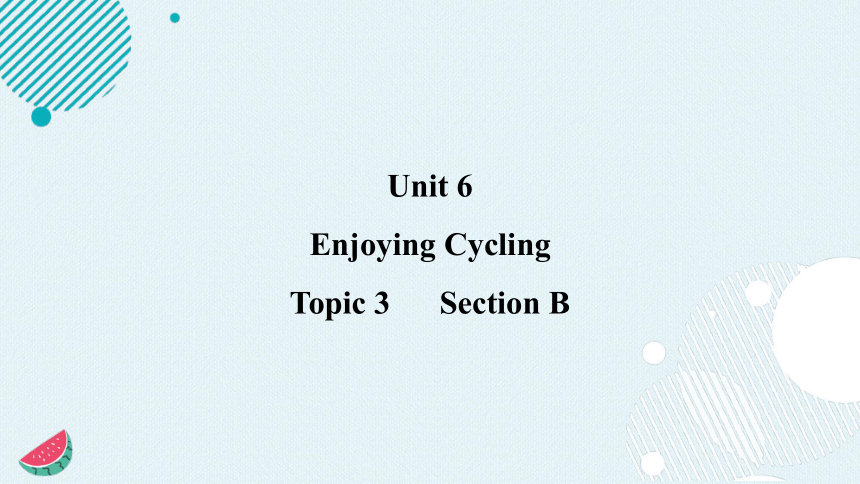 | |
| 格式 | pptx | ||
| 文件大小 | 6.9MB | ||
| 资源类型 | 教案 | ||
| 版本资源 | 仁爱科普版 | ||
| 科目 | 英语 | ||
| 更新时间 | 2024-11-24 00:00:23 | ||
图片预览

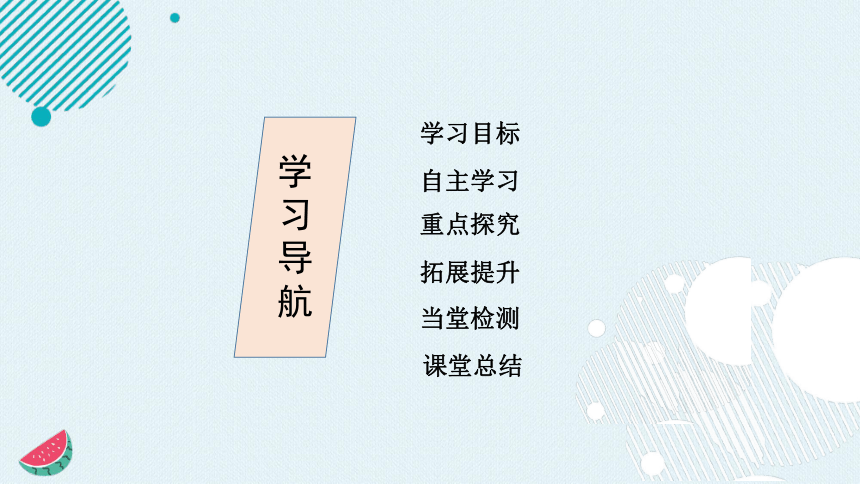
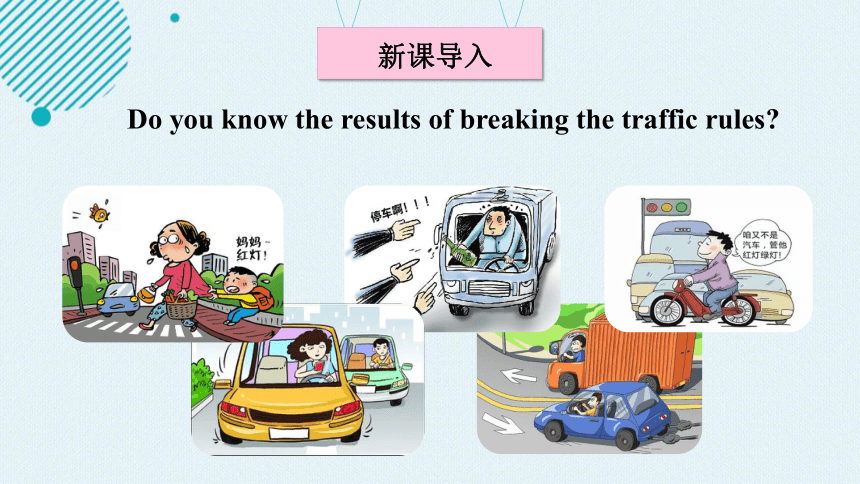
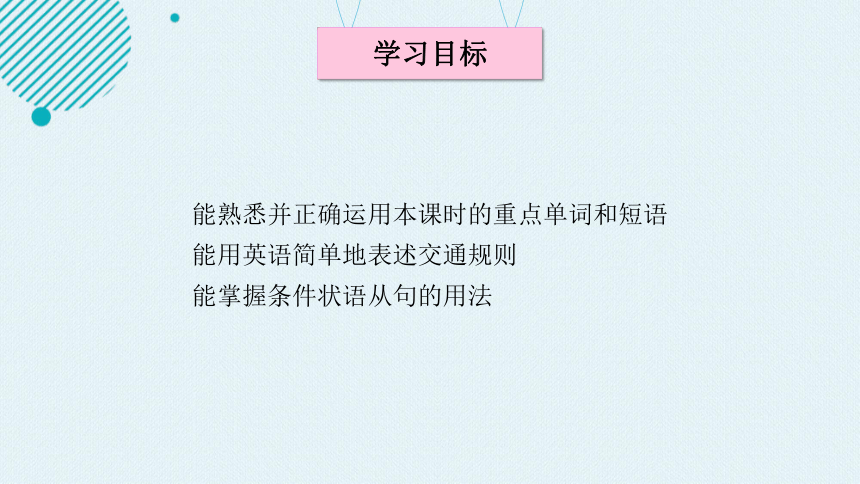
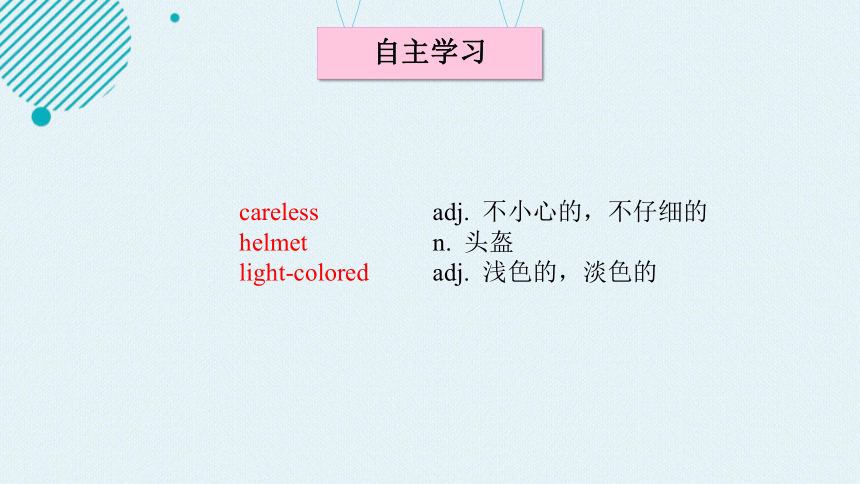
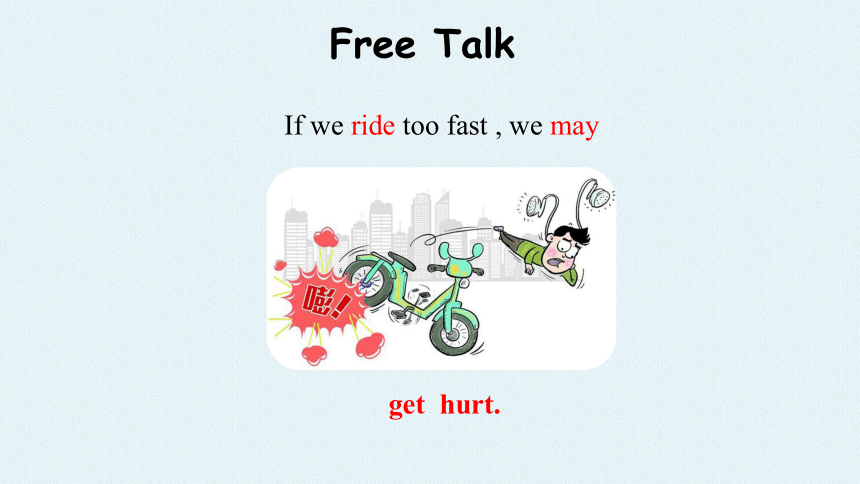
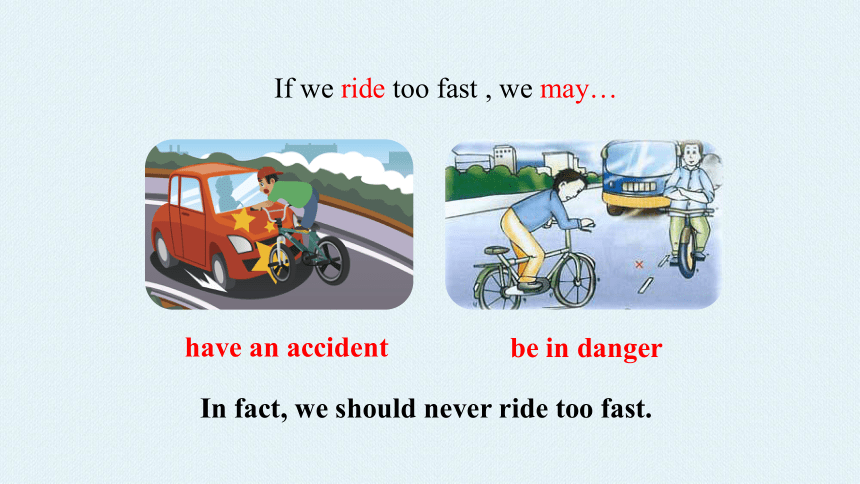
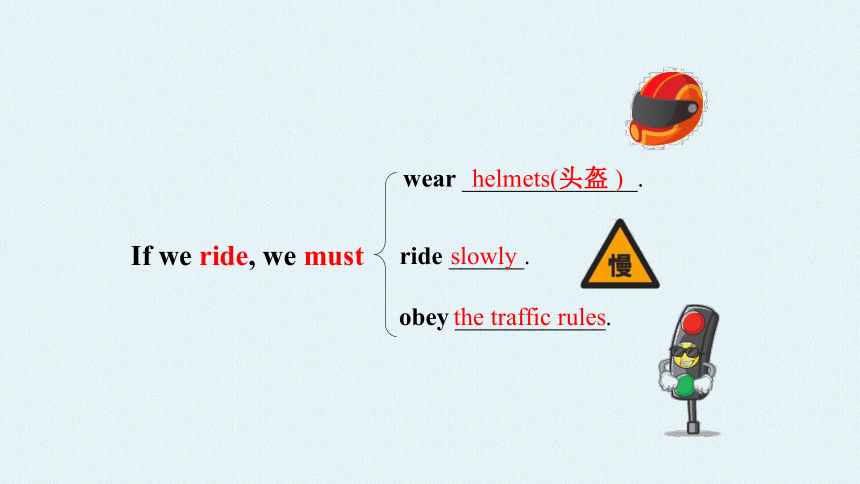

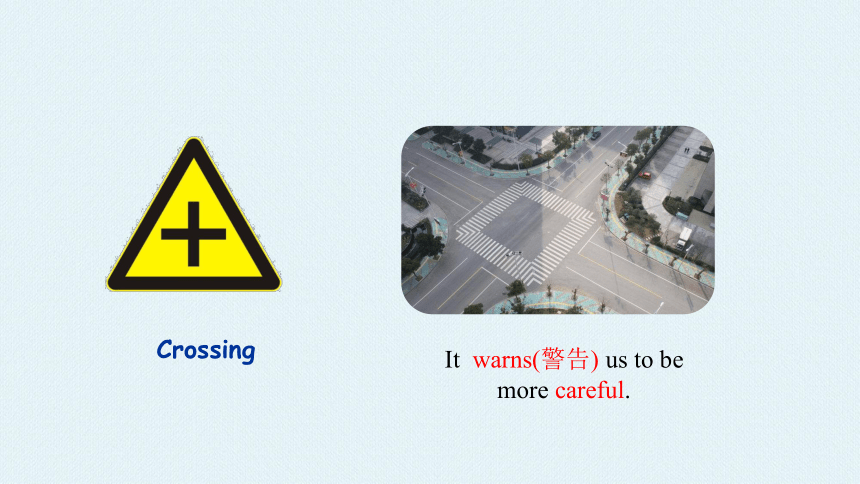
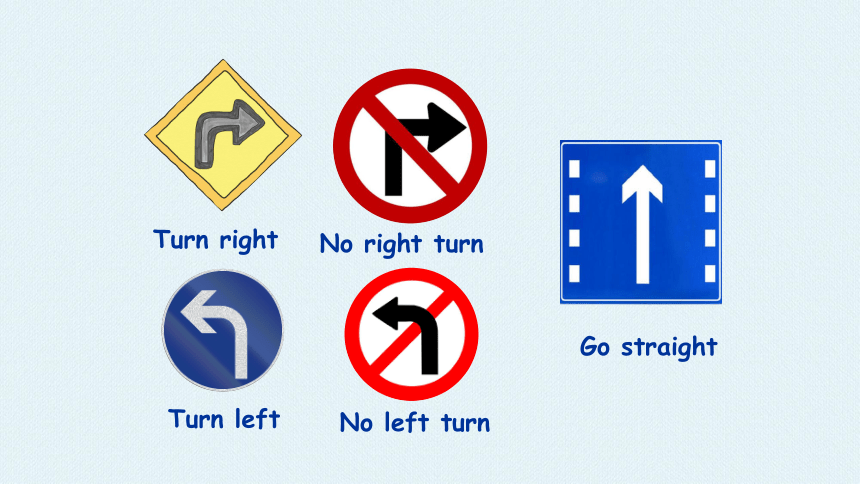
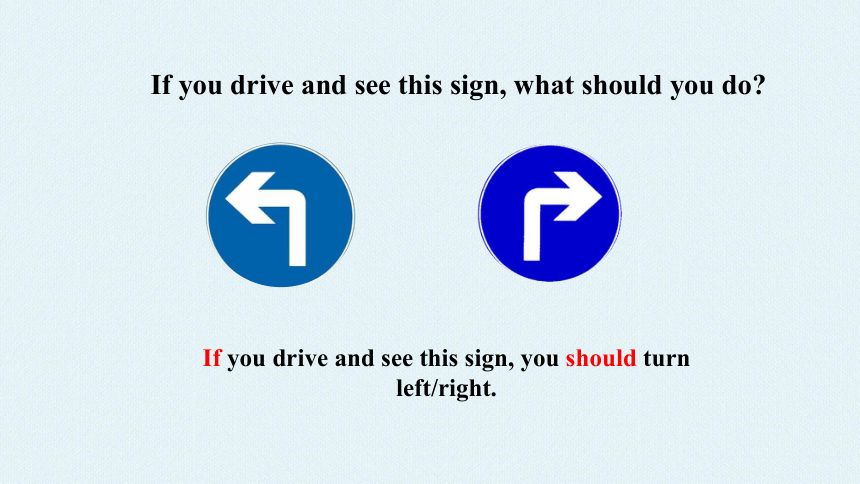
文档简介
(共35张PPT)
Unit 6
Enjoying Cycling
Topic 3 Section B
学习目标
重点探究
自主学习
学习导航
当堂检测
课堂总结
拓展提升
新课导入
Do you know the results of breaking the traffic rules
学习目标
能熟悉并正确运用本课时的重点单词和短语
能用英语简单地表述交通规则
能掌握条件状语从句的用法
自主学习
careless adj. 不小心的,不仔细的
helmet n. 头盔
light-colored adj. 浅色的,淡色的
If we ride too fast , we may
get hurt.
Free Talk
have an accident
be in danger
In fact, we should never ride too fast.
If we ride too fast , we may…
If we ride, we must
wear ______________.
ride ______.
obey ____________.
slowly
helmets(头盔 )
the traffic rules
Traffic lights
Red means stop.
Green means go.
Yellow means wait.
Crossing
It warns(警告) us to be more careful.
Turn right
No left turn
Turn left
No right turn
Go straight
If you drive and see this sign, what should you do
If you drive and see this sign, you should turn left/right.
If you ride a bike and see this sign, what should you do
If you ride a bike and see this sign, you should not ride a bike / turn left.
break the rules
get a fine
Example:
If you break the rules, you will get a fine.
2a Look at the pictures. Discuss the results of
breaking the traffic rules with if. The expressions
under each picture may help you.
重点探究
cross a busy road
be in danger
If you cross a busy road, you will be in danger.
make a wrong turn
cause trouble
If you make a wrong turn, you will cause trouble.
If you don’t drive carefully, you will get hurt.
not drive carefully
get hurt
条件状语从句
(1) 常由if引导,从句可以放在主句之前也可以放于主句之后。如:
If I break the rules, I will get a fine. / I will get a fine if I break the rules.
(2) 条件状语从句的时态:
a. 若主句的动词是一般将来时,从句的谓语动词就用一般现在时,如:
If I cross a busy road, I will be in danger.
b. 在主句中含有can, should, must等情态动词时,从句要用一般现在时,如:
If I make a wrong turn, I may cause trouble.
overloading
drunk driving
drive on the wrong side
talk on the phone while driving
According to 2a and make sentences with if.
1a Look, listen and say.
Kangkang: The bicycle accident in Caishikou Street was
really terrible.
Michael: Yes, it was. The young man on the bicycle was
very careless.
Kangkang: You know, we should never ride too fast. We
should wear bicycle helmets when riding. If we
ride at night, we should have lights on the
bicycle or wear light-colored clothes.
Michael: Certainly. We should also learn more about
the traffic rules. If we break the traffic rules,
we may get a fine and even be in danger.
Kangkang: Why don't we go to a traffic station to learn
more traffic rules
Michael: That's a good idea.
1. Where did the accident happen
2. What was the reason
3. What will Kangkang and Michael do next
In Caishikou Street.
The young man was careless.
They will go to a traffic station to learn more traffic rules.
Read and answer the questions.
We should never ride _____ _____.
We should wear bicycle ________ when riding.
We should have _______ on the bike or wear _____________ clothes while riding at night.
We should learn more about the _____ _____.
too fast
helmets
lights
light-colored
traffic rules
1b Listen to 1a and complete the sentences.
terrible, careless, never, helmets, if…, lights, light-colored,
rules, break, fine, danger
Act out 1a and retell it according to the key words.
( ) 1. If you ride at night,
( ) 2. If you ride on the street,
( ) 3. If you drive a car in
England,
( ) 4. If you drive too fast,
( ) 5. If everyone obeys the
traffic rules,
( ) 6. If you park your car in
the wrong place,
A. you must be careful.
B. you may have an accident.
C. the roads will be safer.
D. you must drive on the left-
hand side of the road.
E. you should have lights on
the bicycle or wear light-
colored clothes.
F. you will get a fine.
A/E
A
D
B/F
C
F
2b Match the two parts of the sentences to make
traffic rules.
The YOUNG man on the bicycle was very careless.
The young MAN on the bicycle was very careless.
The young man on the BICYCLE was very careless.
The young man on the bicycle was very CARELESS.
3a Listen and read these sentences. Pay attention
to the stress and understand the focus of each
sentence.
Example:
Student One: If you ride too fast, you may have an
accident.
Student Two: If you have an accident, you may get hurt.
Student Three: If you are hurt, you won’t be able to go to school.
Student Four: …
3b Work in groups and play the If Chain Game.
Language points
拓展提升
1. The young man on the bicycle was very careless.
骑自行车的那个年轻人很粗心。
1)careless adj. 粗心的;其反义词:careful 细心的,
小心的;
2)on the bicycle 在自行车上;
2. We should wear bicycle helmets when riding.
骑自行车的时候我们应该戴头盔。
此处when riding是“when we are riding”的省略形式。
在以when,while,if等引导的状语从句中,若从句
的主语与主句一致,且含有be,则可以省略从句的
“主语+be”。
e.g.
When (we are) crossing the street, we should be careful.
穿过马路的时候,我们应该要小心。
3. If we break the traffic rules, we may get a fine and even
be in danger.
如果违反了交通规则,我们会受到惩罚,甚至会很
危险。
①break(动词)“打破;违反” break the traffic rules
“违反交通规则”反义词组为obey/follow the traffic
rules “遵守交通规则”
break(名词) “停顿;休息” have/take a break “休息
一下”
②fine (名词) “罚款”,(动词)“处以罚金”。
get a fine“被处以罚金”
e.g.He got a heavy fine.他受到严重处罚。
③be in danger“处于危险中”=be dangerous
“be in +名词”表示处于某种状态中,如:
be in peace 处于和平中
be in trouble 处于困境中
be in good health 处于良好的身体状况中
4. If you make a wrong turn, you will cause trouble.
如果你转错弯,将会导致麻烦。
A. turn此处作名词,意为“(车辆的)转弯,转向;”
e.g. Make a left/right turn into west street.
向左、右入西大街;
B. turn 还可作动词,意为“使转动;旋转;使改变方向;”
常见词组: turn on 打开;turn off 关上;turn down 关小,
拒绝;
e.g. Please turn on the light. 请打开灯!
5. If you drive a car in England, you must drive on the
left-hand side of the road.
如果在英国开车,你必须靠马路左边行驶。
on the left-hand side of the road= on the left of the
road 在马路左边;
on the right-hand side of the road= on the right of the
road 在马路右边;
注意:在左边、右边,用介词on.
当堂检测
1. Do you know the man _____________(骑自行车)
2. If you break the traffic rules, you may ________(罚款).
3. The sign warns us not to ________(向左转).
4. It's dangerous _________________(穿马路) when the
traffic is busy.
5. If you play football on the road, you will _________
(受伤).
一、根据中文提示,用词组的适当形式填空。
on the bicycle
get a fine
turn left
to cross the street
get hurt
课堂总结
Unit 6 Topic 3
Section B
重点单词:
careless, helmet, light-colored
骑自行车的注意事项:
骑自行车时要戴上1._____________夜晚骑车应该穿2._________________学习更多的交通规则” 可以说3.________________________ ,
如果我们违反交通规则会4._______________________ 。
if引导的条件状语从句:
If 引导条件状语从句遵循1.____________的原则,即主句用2.____________,从句用3.___________。
light-colored clothes
learn more about the traffic rules
bicycle helmets
get a fine even be in danger
主将从现
一般将来时
一般现在时
Unit 6
Enjoying Cycling
Topic 3 Section B
学习目标
重点探究
自主学习
学习导航
当堂检测
课堂总结
拓展提升
新课导入
Do you know the results of breaking the traffic rules
学习目标
能熟悉并正确运用本课时的重点单词和短语
能用英语简单地表述交通规则
能掌握条件状语从句的用法
自主学习
careless adj. 不小心的,不仔细的
helmet n. 头盔
light-colored adj. 浅色的,淡色的
If we ride too fast , we may
get hurt.
Free Talk
have an accident
be in danger
In fact, we should never ride too fast.
If we ride too fast , we may…
If we ride, we must
wear ______________.
ride ______.
obey ____________.
slowly
helmets(头盔 )
the traffic rules
Traffic lights
Red means stop.
Green means go.
Yellow means wait.
Crossing
It warns(警告) us to be more careful.
Turn right
No left turn
Turn left
No right turn
Go straight
If you drive and see this sign, what should you do
If you drive and see this sign, you should turn left/right.
If you ride a bike and see this sign, what should you do
If you ride a bike and see this sign, you should not ride a bike / turn left.
break the rules
get a fine
Example:
If you break the rules, you will get a fine.
2a Look at the pictures. Discuss the results of
breaking the traffic rules with if. The expressions
under each picture may help you.
重点探究
cross a busy road
be in danger
If you cross a busy road, you will be in danger.
make a wrong turn
cause trouble
If you make a wrong turn, you will cause trouble.
If you don’t drive carefully, you will get hurt.
not drive carefully
get hurt
条件状语从句
(1) 常由if引导,从句可以放在主句之前也可以放于主句之后。如:
If I break the rules, I will get a fine. / I will get a fine if I break the rules.
(2) 条件状语从句的时态:
a. 若主句的动词是一般将来时,从句的谓语动词就用一般现在时,如:
If I cross a busy road, I will be in danger.
b. 在主句中含有can, should, must等情态动词时,从句要用一般现在时,如:
If I make a wrong turn, I may cause trouble.
overloading
drunk driving
drive on the wrong side
talk on the phone while driving
According to 2a and make sentences with if.
1a Look, listen and say.
Kangkang: The bicycle accident in Caishikou Street was
really terrible.
Michael: Yes, it was. The young man on the bicycle was
very careless.
Kangkang: You know, we should never ride too fast. We
should wear bicycle helmets when riding. If we
ride at night, we should have lights on the
bicycle or wear light-colored clothes.
Michael: Certainly. We should also learn more about
the traffic rules. If we break the traffic rules,
we may get a fine and even be in danger.
Kangkang: Why don't we go to a traffic station to learn
more traffic rules
Michael: That's a good idea.
1. Where did the accident happen
2. What was the reason
3. What will Kangkang and Michael do next
In Caishikou Street.
The young man was careless.
They will go to a traffic station to learn more traffic rules.
Read and answer the questions.
We should never ride _____ _____.
We should wear bicycle ________ when riding.
We should have _______ on the bike or wear _____________ clothes while riding at night.
We should learn more about the _____ _____.
too fast
helmets
lights
light-colored
traffic rules
1b Listen to 1a and complete the sentences.
terrible, careless, never, helmets, if…, lights, light-colored,
rules, break, fine, danger
Act out 1a and retell it according to the key words.
( ) 1. If you ride at night,
( ) 2. If you ride on the street,
( ) 3. If you drive a car in
England,
( ) 4. If you drive too fast,
( ) 5. If everyone obeys the
traffic rules,
( ) 6. If you park your car in
the wrong place,
A. you must be careful.
B. you may have an accident.
C. the roads will be safer.
D. you must drive on the left-
hand side of the road.
E. you should have lights on
the bicycle or wear light-
colored clothes.
F. you will get a fine.
A/E
A
D
B/F
C
F
2b Match the two parts of the sentences to make
traffic rules.
The YOUNG man on the bicycle was very careless.
The young MAN on the bicycle was very careless.
The young man on the BICYCLE was very careless.
The young man on the bicycle was very CARELESS.
3a Listen and read these sentences. Pay attention
to the stress and understand the focus of each
sentence.
Example:
Student One: If you ride too fast, you may have an
accident.
Student Two: If you have an accident, you may get hurt.
Student Three: If you are hurt, you won’t be able to go to school.
Student Four: …
3b Work in groups and play the If Chain Game.
Language points
拓展提升
1. The young man on the bicycle was very careless.
骑自行车的那个年轻人很粗心。
1)careless adj. 粗心的;其反义词:careful 细心的,
小心的;
2)on the bicycle 在自行车上;
2. We should wear bicycle helmets when riding.
骑自行车的时候我们应该戴头盔。
此处when riding是“when we are riding”的省略形式。
在以when,while,if等引导的状语从句中,若从句
的主语与主句一致,且含有be,则可以省略从句的
“主语+be”。
e.g.
When (we are) crossing the street, we should be careful.
穿过马路的时候,我们应该要小心。
3. If we break the traffic rules, we may get a fine and even
be in danger.
如果违反了交通规则,我们会受到惩罚,甚至会很
危险。
①break(动词)“打破;违反” break the traffic rules
“违反交通规则”反义词组为obey/follow the traffic
rules “遵守交通规则”
break(名词) “停顿;休息” have/take a break “休息
一下”
②fine (名词) “罚款”,(动词)“处以罚金”。
get a fine“被处以罚金”
e.g.He got a heavy fine.他受到严重处罚。
③be in danger“处于危险中”=be dangerous
“be in +名词”表示处于某种状态中,如:
be in peace 处于和平中
be in trouble 处于困境中
be in good health 处于良好的身体状况中
4. If you make a wrong turn, you will cause trouble.
如果你转错弯,将会导致麻烦。
A. turn此处作名词,意为“(车辆的)转弯,转向;”
e.g. Make a left/right turn into west street.
向左、右入西大街;
B. turn 还可作动词,意为“使转动;旋转;使改变方向;”
常见词组: turn on 打开;turn off 关上;turn down 关小,
拒绝;
e.g. Please turn on the light. 请打开灯!
5. If you drive a car in England, you must drive on the
left-hand side of the road.
如果在英国开车,你必须靠马路左边行驶。
on the left-hand side of the road= on the left of the
road 在马路左边;
on the right-hand side of the road= on the right of the
road 在马路右边;
注意:在左边、右边,用介词on.
当堂检测
1. Do you know the man _____________(骑自行车)
2. If you break the traffic rules, you may ________(罚款).
3. The sign warns us not to ________(向左转).
4. It's dangerous _________________(穿马路) when the
traffic is busy.
5. If you play football on the road, you will _________
(受伤).
一、根据中文提示,用词组的适当形式填空。
on the bicycle
get a fine
turn left
to cross the street
get hurt
课堂总结
Unit 6 Topic 3
Section B
重点单词:
careless, helmet, light-colored
骑自行车的注意事项:
骑自行车时要戴上1._____________夜晚骑车应该穿2._________________学习更多的交通规则” 可以说3.________________________ ,
如果我们违反交通规则会4._______________________ 。
if引导的条件状语从句:
If 引导条件状语从句遵循1.____________的原则,即主句用2.____________,从句用3.___________。
light-colored clothes
learn more about the traffic rules
bicycle helmets
get a fine even be in danger
主将从现
一般将来时
一般现在时
同课章节目录
- Unit 5 Feeling excited
- Topic 1 You look excited
- Topic 2 I’m feeling better now.
- Topic 3 Many things can affect our feelings.
- Unit 6 Enjoying Cycling
- Topic 1 We're going on a three-day visit to Mount
- Topic 2 How about exploring Tian’anmen Square?
- Topic 3 Bicycle riding is good exercise.
- Unit 7 Food festival
- Topic 1 We’re preparing for a food festival.
- Topic 2 I’m not sure whether I can cook it well.
- Topic 3 I Cooked the Most Successfully
- Unit 8 Our Clothes
- Topic 1 We will have a class fashion show.
- Topic 2 We can design our own uniforms.
- Topic 3 He said the fashion show was wonderful.
